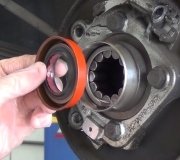The two have nothing to do with each other. You can go to the grocery store for chips and pretzels for tonight's football game, and go back tomorrow for next week's tv dinners. You're only out the second trip. Same with the transmission service. You'll make a second trip, but the service has nothing to do with engine oil.
If you haven't noticed a problem until now, there's probably nothing to worry about. The guys at Jiffy Lube were simply doing their job by looking for potential problems. That's better than the alternative: not saying anything and letting problems catch up to you on the road.
Most full service repair shops, new car dealerships in particular, maintain a service history of your vehicle. They would have seen that they told you about the leak many visits ago, and it hasn't gotten any worse or caused a problem. Because of that knowledge, they won't bring it up again. Jiffy Lube doesn't know the vehicle's history, so they erred on the side of caution rather than complacency. Good for them.
With the low miles you drive, and the fact you haven't been seeing puddles where you park, I'd suggest forgetting about changing the fluid for now. If it will put things in perspective, ... My '88 Grand Caravan has over 217,000 miles, and the transmission fluid and filter have only been changed once. That was at around 90,000 miles, and only because a 4 dollar side cover had a small hole rusted through it. As long as the fluid was going to drain out to replace that side cover, (not the differential cover), I decided to replace the fluid and filter. Nothing has been done to the transmission since, and I use it twice per year to pull an enclosed trailer that's bigger and heavier than the entire van! This is no longer neglect; this is abuse.
There's one extremely important fact to be aware of. My transmission is the old three speed based on the really tough transmissions used in the late 1960s through the late 1980s. They're hard to damage. You're transmission is the computer-controlled four speed with overdrive. (You will see a circle around the "3" on the shift indicator on the instrument cluster). I have a '95 Grand Caravan with that transmission. The idea behind it is really neat, (too long to describe here), but it's a wimp. If I used that van to pull my trailer, the transmission would explode before I got to the end of my driveway! In fact, that van is on its third transmission, (second replacement) at 120,000 miles. GM and Ford transmissions are just as bad. A lot of youngsters today, such as my former students, think it's normal to have your transmission replaced twice in the life of the vehicle. Yeah, it is today, but that wasn't the case 20 years ago.
With your transmission, there are actually three covers. The "pan" is the one that's removed to drain the fluid and access the filter for replacement. The differential cover is on the back. The differential is actually the rear axle built into the transmission for use in front wheel drive cars. It allows the two tires to turn at different speeds when going around a corner. That cover is only removed when it's leaking, as in your case, or when one of the catastrophic events occurs. There's a large pin that's held in place by a small bolt. The small bolt can break, often from harsh shifting back and forth trying to get unstuck in a snow pile, and it allows the large pin to slide out of place and catch on the transmission case. That's what happened to the first replacement on my '95. The case actually cracked open on the road. When the differential cover is off, the mechanic should inspect that bolt and pin, but I wouldn't bother taking the cover off simply to do an inspection. The third cover is the side pan I mentioned. No need to remove that one either unless it's leaking. There's just two gears in there, nothing else.
The rear axle, (from older cars), is built into the transmission for use in front wheel drive cars and vans. That's why they call it a "transaxle". Look for the red puddle between the two front tires, closer to the left one.
As for the radiator, the transmission cooler is built into it. There is a tube going through it that has two hoses going to the transmission. There really isn't that much fluid in the tube, and it shouldn't have lost enough to cause a problem.
Hope that helps.
Caradiodoc
Saturday, December 5th, 2009 AT 1:53 AM



